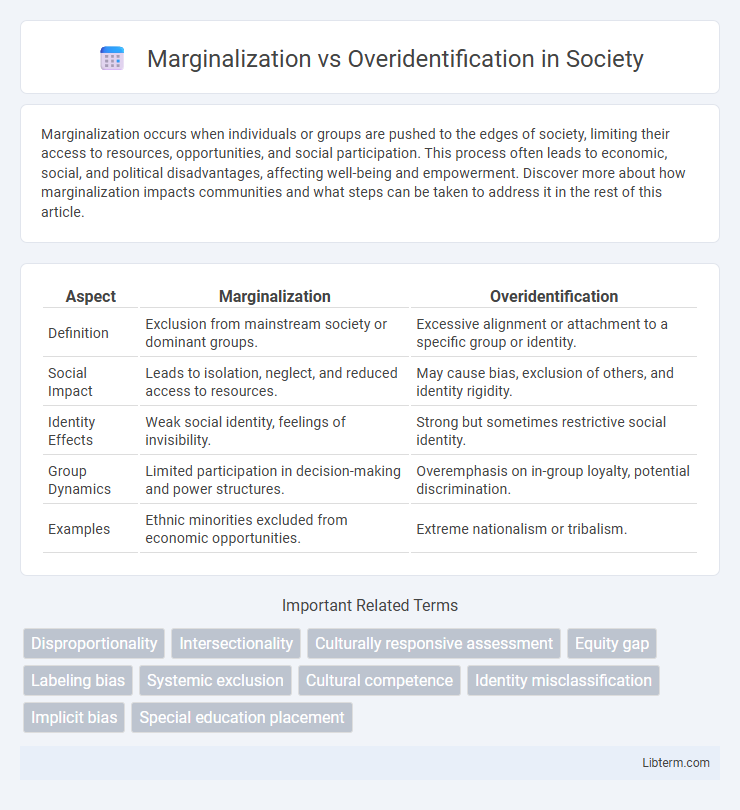Marginalization occurs when individuals or groups are pushed to the edges of society, limiting their access to resources, opportunities, and social participation. This process often leads to economic, social, and political disadvantages, affecting well-being and empowerment. Discover more about how marginalization impacts communities and what steps can be taken to address it in the rest of this article.
Table of Comparison
| Aspect | Marginalization | Overidentification |
|---|---|---|
| Definition | Exclusion from mainstream society or dominant groups. | Excessive alignment or attachment to a specific group or identity. |
| Social Impact | Leads to isolation, neglect, and reduced access to resources. | May cause bias, exclusion of others, and identity rigidity. |
| Identity Effects | Weak social identity, feelings of invisibility. | Strong but sometimes restrictive social identity. |
| Group Dynamics | Limited participation in decision-making and power structures. | Overemphasis on in-group loyalty, potential discrimination. |
| Examples | Ethnic minorities excluded from economic opportunities. | Extreme nationalism or tribalism. |
Understanding Marginalization: A Brief Overview
Marginalization refers to the social process by which certain groups or individuals are pushed to the edges of society, limiting their access to resources, rights, and opportunities. This exclusion often results from systemic inequalities based on race, gender, socioeconomic status, or other identity factors. Understanding marginalization requires examining power dynamics and structural barriers that prevent full participation in social, economic, and political life.
Defining Overidentification in Social Contexts
Overidentification in social contexts occurs when individuals or groups excessively associate their identity with a particular social category, leading to rigid self-conceptions and exclusion of other aspects of their identity. This often results in reinforcing stereotypes and limiting personal or collective growth by overemphasizing a single dimension of social belonging. Contrasting with marginalization, overidentification can create social isolation through an intense focus on group boundaries rather than inclusive interactions.
Key Differences Between Marginalization and Overidentification
Marginalization involves excluding or ignoring certain groups or ideas, leading to reduced influence and participation, whereas overidentification refers to an excessive association or attachment to a particular identity or perspective, often resulting in bias and lack of objectivity. Key differences include the direction of impact: marginalization diminishes visibility and power, while overidentification amplifies alignment to specific traits or beliefs. Marginalization causes social isolation or neglect, while overidentification can cause stereotyping and limit critical thinking due to emotional overinvestment.
Causes of Marginalization in Society
Marginalization in society often stems from systemic inequalities such as economic disparity, social exclusion, and discriminatory practices based on race, gender, or ethnicity. Limited access to education, healthcare, and employment opportunities perpetuates the cycle of marginalization by hindering individuals' social mobility. Cultural biases and political neglect further reinforce social isolation, contrasting with overidentification, where individuals excessively align with a group identity.
Factors Leading to Overidentification
Factors leading to overidentification include an excessive reliance on stereotypes and a strong desire for belonging within a social group, which causes individuals to adopt group identities rigidly. High levels of social pressure and a lack of critical self-reflection increase the risk of losing individual distinctiveness in favor of collective identity. Cognitive biases and emotional investments further intensify this process, reinforcing overidentification with specific ideologies or communities at the expense of personal autonomy.
Impact of Marginalization on Communities
Marginalization systematically excludes groups from access to resources, opportunities, and social participation, resulting in increased poverty, reduced educational attainment, and limited healthcare access within affected communities. This exclusion fosters social fragmentation, erodes cultural identity, and heightens vulnerability to discrimination and violence. Persistent marginalization diminishes community resilience, perpetuating cycles of inequality and hindering collective economic and social development.
The Effects of Overidentification on Individual Identity
Overidentification can distort individual identity by causing a person to conflate their self-worth with group membership or external labels, leading to reduced personal autonomy and critical self-reflection. This phenomenon often results in rigid self-concepts that limit personal growth and increase susceptibility to group biases or ideological extremism. Persistent overidentification may also hinder adaptive coping mechanisms, fostering social isolation or conflict when group identities clash.
Addressing Marginalization: Effective Strategies
Addressing marginalization requires targeted community engagement that fosters inclusivity and ensures representation of diverse voices in decision-making processes. Implementing equitable access to resources and opportunities, such as education, healthcare, and employment, helps reduce systemic barriers faced by marginalized groups. Continuous evaluation and adaptation of policies based on feedback from affected populations strengthen the effectiveness of these strategies and promote social equity.
Solutions for Mitigating Overidentification Risks
Implementing differential privacy techniques reduces data re-identification risks by introducing noise to datasets while preserving overall utility. Employing access controls and strict data governance policies limits exposure to sensitive information, thereby minimizing overidentification. Continuous monitoring with anomaly detection tools helps identify and prevent unauthorized data linkages that lead to privacy breaches.
Moving Forward: Building Inclusive and Balanced Societies
Moving forward, building inclusive and balanced societies requires addressing marginalization by ensuring equal access to resources and opportunities for all groups. Strategies to prevent overidentification involve recognizing diverse identities without stereotyping or reducing individuals to single narratives. Promoting dialogue, equity policies, and cultural competency education fosters social cohesion and resilient communities.
Marginalization Infographic

 libterm.com
libterm.com